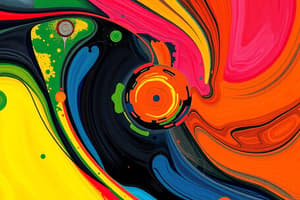Podcast
Questions and Answers
What is matter?
What is matter?
Material which makes up everything in the universe.
What are the two types of classification of matter mentioned?
What are the two types of classification of matter mentioned?
Physical properties and chemical nature.
All things have mass and occupy space.
All things have mass and occupy space.
True (A)
According to early Indian philosophers, the five basic elements are air, earth, fire, sky, and _____
According to early Indian philosophers, the five basic elements are air, earth, fire, sky, and _____
What happens to salt when it is dissolved in water?
What happens to salt when it is dissolved in water?
The SI unit of mass is _____
The SI unit of mass is _____
Which of the following represents a school of thought regarding the nature of matter?
Which of the following represents a school of thought regarding the nature of matter?
What activity can demonstrate if matter is continuous or particulate?
What activity can demonstrate if matter is continuous or particulate?
1 liter is equal to _____ mL.
1 liter is equal to _____ mL.
What happens when an incense stick is lit?
What happens when an incense stick is lit?
Study Notes
Introduction to Matter
- Matter is defined as anything that has mass and occupies space.
- Everything around us, including air, food, stones, clouds, and plants, is composed of matter.
Historical Perspectives on Matter
- Early Indian philosophers classified matter into five basic elements known as "Panch Tatva": air, earth, fire, sky, and water.
- Ancient Greek philosophers had a similar classification system.
- Modern scientists classify matter based on physical properties and chemical nature.
Physical Properties of Matter
- This chapter focuses on understanding matter through its physical properties.
Nature of Matter
- Two contrasting schools of thought exist: one views matter as continuous (e.g., a block of wood), while the other sees it as made up of particles (e.g., sand).
Experiments Demonstrating Matter's Properties
-
Activity 1.1: Dissolving salt or sugar in water shows how these particles spread throughout the liquid, leading to observations about water level changes.
-
Activity 1.2: Testing potassium permanganate's diffusion in water illustrates the particulate nature of matter.
-
Repeated dilution of colored solutions helps demonstrate particle distribution, even in small amounts.
Movement of Particles
- Activity 1.3: Lighting an incense stick and observing how the smell spreads shows that particles in matter are constantly moving.
Understanding Scale of Particles
- Activity 1.4: Comparing glasses of water reinforces the concept of particles and their size, as well as their ability to mix and spread.
Key Concepts
- Matter is composed of microscopic particles that are dynamic and continuously move and interact.
- Understanding the nature of matter involves both intuitive observations and scientific experimentation.
Studying That Suits You
Use AI to generate personalized quizzes and flashcards to suit your learning preferences.
Description
Explore the fundamental concepts of matter with this quiz based on Chapter 1. Understand the various forms and properties of matter that make up our surroundings, including practical activities to enhance your learning experience.




